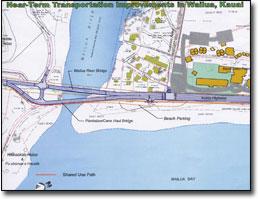LIHU’E — All that stands in the way of alleviating the Kuhio Highway bottleneck in Wailua is $5 million and at least 18 more months of snarled traffic.
And those funds are still not secured, according to Brennon Morioka, deputy director of the Highways Division of the state Department of Transportation.
“We are making a supplementary-budget increase going into the 2006 Legislative session,” Morioka told a regularly-scheduled meeting of the Governor’s Advisory Board last week at the Lihu’e Civic Center.
Carrying out short-term plans, including widening Kuhio Highway from Kuamo’o Road in Wailua to the temporary Kapa’a bypass road, certain parts of Kuhio Highway by Wailua Bay, and Kuamo’o Road, could happen sooner than later because of the relatively lower cost, he said.
At a meeting in August attended by Gov. Linda Lingle and DOT officials, Kaua’i Mayor Bryan J. Baptiste stressed a significant amount of coordination among county, state and federal agencies has been “ongoing” for this project.
Baptiste said the group members have focused their attention on undergrounding utilities, possible drainage issues, and more detailed traffic counts to improve traffic flow at intersections.
Morioka said that, once funds are secured, and he said he is confident that will happen, construction on the Kuhio Highway bypass and Kuamo’o Road project could begin within 18 months.
Morioka said this facet had few land issues involved, and could be fasttracked. He also told members of the Governor’s Advisory Board that the developers of the Coco Palms Resort have pledged cooperation in assisting with design plans.
“They’ll be using their own design consultant. They do have an obligation to provide traffic-congestion mitigation,” Morioka said.
He warned that adding more room for traffic was not necessarily a win-win situation.
“Adding capacity is not the cure-all. More capacity encourages people to drive. What we need is a holistic look at the traffic problem,” he said.
Some ideas, actually more of a wish-list introduced in August, include a short-term solution for East Kaua’i traffic problems that looks like this:
- Installing an Acro Bridge (a temporary bridge) on top of an existing, single-lane, haul-cane bridge that spans the Wailua River, and turning the bridge into a two-lane bridge. The conversion would provide a third northbound lane to Kapa’a and beyond. Development of some type of bridge project, in an extreme case, could cost an estimated $10 million, Morioka said.
Some of the long-term solutions to resolve inbound traffic to Lihu’e discussed in August amongst Lingle, DOT officials and Baptiste, include:
- Expanding Kaumuali’i Highway from Rice Street to Puhi Road into four lanes in the future, a “first-phase” project that could be developed at an estimated cost of between $25 million to $35 million;
- Expanding the highway from Puhi Road to Maluhia Road into four lanes in the future.
Both projects could be developed at an estimated cost of $150 million, Baptiste said.
Officials also identified DOT projects they said have helped mitigate traffic congestion on Kaua’i:
- Widening the two-lane Waika’ea Canal bridge of Kuhio Highway into three lanes, and building an acceleration lane that could be used as a fourth lane over the bridge;
- Installing traffic signals and making improvements at the Koloa Road intersection, and widening of the Lawa’i bridge of Kaumuali’i Highway from two to four lanes;
- Adjusting signal lights to provide an “optimal of through time” on Kuhio Highway at Kuamo’o Road and Haleilio Road in Wailua;
- Expanding the temporary Kapa’a bypass road.
Morioka said private-sector leaders need to look at incentives to limit the number of cars on the roads, including the use of carpools, and using public transportation.




